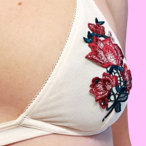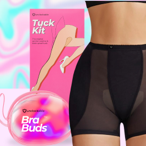
My Journey + What is Gender Dysphoria? How do I manage it?
My Journey + What is Gender Dysphoria? How do I manage it?
Hey! Maddie here. Inventor of Tuck Kit!
Living in Queens— home to the largest Greek community outside of Greece— I feel the urge to channel the grandfather from the movie My Big Fat Greek Wedding here…
The term "dysphoria" originates from two Greek words, which together help us understand the meaning behind the word.
-
"Dys-" is a prefix in Greek that means "difficult”. It is often used to create words that convey a negative or problematic state.
- "Phoria" comes from the Greek word "pherein," which means "to bear" or "to carry.
When combined, "dysphoria" literally translates to "difficult to bear" or "hard to carry." In the context of gender dysphoria or other forms of dysphoria, it reflects the emotional and psychological distress experienced by individuals who find it challenging to bear or cope with their feelings related to their gender identity, body, or other aspects of their lives.
Disclaimer:
This blog post is meant for informational and educational purposes only. It is not a substitute for professional medical advice, diagnosis, or treatment. While we aim for accuracy, we cannot guarantee the completeness or reliability of the information provided.
If you're experiencing gender dysphoria, it's vital to consult with qualified healthcare professionals. Do not rely solely on this content for your health or mental well-being.
What is Gender Dysphoria?

Ah, me in the early days. Peak dysphoria. But what is it? Gender dysphoria is the discomfort experienced when a person's gender identity doesn't align with their assigned sex at birth. While this definition offers a basic understanding, it doesn't capture the full impact on the lives of those going through it.
Gender dysphoria is classified as a medical condition, which acknowledges the need for proper support and understanding for those affected. Recognizing it as a legitimate condition emphasizes the importance of providing appropriate care and resources for individuals experiencing dysphoria. This includes access to mental health services, hormone therapy, and gender-affirming surgeries when necessary, to improve their overall wellbeing and quality of life.
In this article, we'll take a more in-depth look and discuss strategies and tips for managing gender dysphoria and its different manifestations. But before we do, it's important to note that this article is meant for informational purposes only. The content doesn't constitute medical, psychological or professional advice and should never be used as a substitute for a licensed healthcare professional.
I just want to say before we begin: you are in the driver's seat. You are a whole person, outside of your gender identity.
It's important to remember that you are not defined solely by your dysphoria. While it is a significant aspect of the transgender experience, it doesn't have to define you. You’re a complex individual with multifaceted qualities, talents, and passions that go beyond any challenges you may face.
Embracing your authentic self means recognizing and celebrating all aspects of who you are. Remember to nurture your interests, cultivate your strengths, and pursue your dreams, as you have the power to shape your own narrative and live a fulfilling and meaningful life.
Everyone's experience with gender dysphoria is unique, so not all of the symptoms and triggers discussed in this post may apply to you. If you find that your or a loved one's experiences align with the symptoms and triggers discussed, we urge you to reach out to a healthcare expert experienced in the field of gender identity for an official diagnosis. They can provide guidance, support, and the appropriate resources to help you better understand your feelings and explore the best path forward for you. It’s essential to avoid self diagnosing, as it can be inaccurate and cause unnecessary stress and confusion.
My Personal Story & "Diagnosis"

Just four years ago, I was diagnosed with F64.2, a diagnostic code under the ICD-10 (International Classification of Diseases, 10th revision). Yes, diseases. Yikes. Now, this code specifically refers to "Gender Identity Disorder in Adolescents and Adults." At the time, it felt like a heavy burden. The term "disorder" made me feel as though there was something inherently wrong with me, rather than acknowledging the distress I was experiencing due to the incongruence between my gender identity and my assigned sex at birth. It's worth mentioning that homosexuality also used to be in the DSM. The shift in terminology from GID to gender dysphoria in the DSM-5 has been an important step towards de-stigmatizing the experiences of people like me and recognizing that the problem is not with our identities, but with the distress we experience due to societal pressures and expectations.
Through the whirlwinds of my self-discovery, I've realized that my identity does not fit within the constraints of the traditional binary system. I initially transitioned from presenting as male to a more femme aesthetic, and even dipped my toes into the world of hormone therapy. Well, I went on HRT for a year-- maybe that's more waist-deep than toe-dipping. Anyway, this exploration allowed me to understand my identity on a deeper level, but the rigid structures of gender still felt constraining. It was like trying to fit a square peg into a round hole.
My experiences had shaped me into something that was neither strictly male nor female; my identity had become fluid and dynamic. Today, I identify as gender non-conforming. I'm no longer bound by societal norms or expectations about how I should present myself or what my role should be. The journey to this point has been marked with its fair share of hurdles and complexities, but each step has brought me closer to understanding and accepting the full spectrum of my identity. Now, I feel more like myself than ever before, a unique individual who exists beyond the confines of the gender binary. It's a testament to the continuous evolution of identity and a reminder that our personal narratives are far from stagnant. They're constantly developing, shaped by our experiences and the way we perceive ourselves.
By exploring gender, you're exploring what makes you YOU. And there's something thrilling about that. Let's dive in!
What are the different kinds of gender dysphoria?
Gender dysphoria can manifest in a lot of different ways. Here are a few of the most common experiences:
Body Dysphoria:
Body dysphoria involves anxiety and unhappiness with one's own body, especially with physical features associated with their assigned sex. A transgender woman could be upset by facial hair or a masculine jawline, while a transgender man could be uncomfortable about their breasts or hips. Ultimately this can take a serious toll on mental health, and many people end up looking into treatments like hormone therapy or gender-affirming surgeries to feel more comfortable in their bodies.
Bottom dysphoria is a specific type of body dysphoria that is characterized by distress related to the genital area. For trans women, bottom dysphoria may include the desire to have a vagina, as one might have if their body matched their internal sense of self.
Top dysphoria, on the other hand, refers to the distress and discomfort that trans women may experience related to their chest or breast area. For many trans women, having a flat or masculine chest can be a constant reminder of their assigned sex at birth and can contribute to feelings of dysphoria.
It's important to note that not all trans folks choose to pursue surgical interventions, and each person's journey is unique. Some individuals may find relief through other means, such as wearing padded undergarments, which can create the desired feminine silhouette and improve their sense of self.
Note: The use of terms like "top dysphoria" and "bottom dysphoria" has been subject to discussions within and outside the transgender community. Some argue that these terms can be seen as needless euphemisms; or, at worst, terms that may trivialize surgery or perpetuate gendered stereotypes. However, it's important to consider that these terms serve a purpose in de-medicalizing the language surrounding secondary sex characteristics, which often themselves can be dysphoria triggers. By using these terms, the focus shifts from medical terminology to a more inclusive and relatable language that acknowledges the unique experiences of transgender individuals.
Voice Dysphoria
When someone feels their voice doesn't match their gender identity, it can trigger feelings of dysphoria. If a trans woman's voice is too deep for example, or a trans man has a higher-pitched voice, that could trigger feelings of dysphoria. This can make social situations tricky and even cause issues at the workplace. Luckily, speech therapy and gender-affirming surgeries are available and make a huge difference!
Sexual Dysphoria
Sexual dysphoria causes feelings of distress and dissociation during intimate and sexual activities, due to the incongruence of one's body and gender identity. This makes maintaining romantic relationships and intimate connections even harder than they already are, which is why it's so essential for anyone going through this to be honest with their partners and ideally work through their feelings with a trained professional. Maybe even a couples' therapist!
Gender Role Dysphoria
Just because gender roles are a social construct, doesn't change the very real pressures placed on us by society to fit into those roles. And when your own self-perception is at odds with ingrained societal expectations, it's no surprise that it could trigger feelings of dysphoria. An example of gender role dysphoria could be something like say, a trans woman being made to wear a suit and tie to work, or a non binary person being addressed as “ma'am.” Working through these feelings often means challenging traditional norms and getting involved in supportive LGBTQ+ communities (more on that later!).
What causes gender dysphoria?
The exact reasons for gender dysphoria remain a bit of a mystery, with no one-size-fits-all explanation. Various theories try to pinpoint its causes, ranging from biological to psychological factors. While many people become aware of gender incongruence during childhood, it's important to note that gender dysphoria can show up at any age.
And as common as gender dysphoria is amongst non-binary and transgender people, believe it or not...
Not all transgender people experience gender dysphoria
There's a misconception that the two automatically go hand in hand. There's even a term for this idea: “Transmedicalism.” Transmedicalists believe that if you don't experience dysphoria and don't pursue HRT or gender confirming surgeries, it isn't 'legitimate.'
We don't subscribe to that philosophy. The reality is, everyone's journey is different. Some people experience intense gender dysphoria which they struggle to manage, some people have mild dysphoria which comes and goes, and some people don't experience it at all. All are valid!
That said, while not universal, it is common and if you're looking for advice for yourself or a loved one, you've come to the right place.
Microdysphoria
As shown, gender dysphoria can manifest in various ways. However, one under-discussed aspect of gender dysphoria is 'microdysphoria' - the small, everyday experiences that can trigger feelings of unease or discomfort related to one's gender identity. Being aware of common dysphoria triggers can help individuals manage their experience more effectively.
Some examples of these triggers might include...
-
Pronouns: Someone using an incorrect pronoun in casual conversation
-
Deadnaming: Being called by your birth name rather than your chosen name
-
Healthcare experiences: Encountering gendered language on forms or documents
-
Unexpected reflections: Experiencing discomfort or distress upon unexpectedly catching a glimpse of your reflection in a mirror or other reflective surface
-
Gender-segregated environments: Feeling out of place in gender-segregated spaces like public restrooms or locker rooms. (Using the public restroom as a trans woman in particular can be stressful!)
Though these incidents may seem minor in isolation, the cumulative effect of microdysphoria can significantly impact an individual's mental well-being and sense of belonging. Acknowledging and addressing these less obvious manifestations of gender dysphoria can provide a more comprehensive understanding of the transgender experience and offer support for those navigating these challenges in their daily lives.
Creating a support network

Surrounding yourself with supportive people who respect your pronouns, name and identity, is so important when it comes to mental health. But also it's completely justified to be nervous about coming out, which is why you should only ever do it at the time and pace you're comfortable with.
Try starting in small steps, telling just your closest loved ones at first. You may be surprised by how accepting they are, and the relief in freely being your true self around those who are most important to you can be a game changer. But if you're not quite ready for that yet, it's ok!
The unfortunate reality is, not everyone has supportive people in their lives, and a refusal to respect your identity can increase negative feelings. In these cases, all we can do is hope they'll come around one day, but until they do we suggest limiting time around them as much as possible.
LGBTQ+ communities
Whether you decide to share your identity with people in your life or not, it's a good idea to hook up with local support groups where you can build relationships with likeminded people with similar experiences. People who can offer guidance based on their own histories, celebrate your victories, and comfort you during your struggles.
Many larger cities have in-person LGBTQ+ support groups and activities, but there are also many online resources for connecting with other members of the community. Websites such as The Trevor Project and GLAAD have entire databases of groups where you can talk with people and become more involved in the community.
Online resources like The Dysphoria Bible can provide information, guidance, and support for individuals experiencing dysphoria. While it can be a valuable starting point for those seeking to understand and cope with their feelings, it is essential to also consult with a mental health professional for personalized care and support. They can help individuals navigate their unique experiences and develop a tailored treatment plan that addresses their specific needs and goals.
Changing your outer appearance to reflect your inner identity

While there's certainly a lot more to gender identity than what we see on the surface, visual appearances can definitely influence how we perceive ourselves and others.
When forced to dress as the opposite gender in order to fit in, it can increase negative feelings of dysphoria. It makes sense then that adjusting our appearances to reflect our true identities could do just the opposite, helping us access feelings of gender euphoria.
There are tons of accessible and DIY options out there for male to female transformations, which can all be more or less adapted to fit the comfort level of each person.
Hairstyle
The way you style your hair can have a profound effect on how you perceive yourself. Simple changes, like parting your hair differently, growing bangs, layering your hair, or even just adding fun accessories like bows or ribbons, can easily feminize facial features and boost confidence when looking in the mirror.
Wigs are also a great option for people who maybe aren't ready to commit to one look or who want to test out different styles. Whether you go with your natural hair or a wig or both, I definitely recommend finding a good stylist who can work with you to achieve your goals!
Gender-affirming shapewear
Unsurprisingly, making changes to our wardrobes can make a major positive impact on gender identity. Clothing is a simple, fun way for us to express ourselves authentically, and a powerful tool for shaping our images to match our inner-identities.
Undergarments alone open up an entire world, including padded bras, pocket bras and mastectomy bras which are designed to hold prosthetic inserts, and padded underwear which can help accentuate our hips and butt. There's pretty much endless options of gender-affirming clothing out there we can use for male to female transformations to look and feel curvier and more feminine in our bodies, so have fun with it and start hitting those shops!
Makeup
With some experimentation and the right techniques, makeup can be used super effectively to feminize and emphasize some facial features while de-emphasizing others. For example, gentle highlights can be used to soften more masculine brows, while a matte foundation can help conceal shadow and even out skin tones.
For anyone new to makeup, you should try to start with the basics! Eventually with practice, you'll build up your skills and learn the best techniques for expressing your gender identity. YouTube tutorials are a fantastic way to learn some easy tips, with countless how-to videos out there for beginners to get you started.
Tucking
Tucking, a method for concealing the penis and testicles and creating a visually smooth contour, is often seen as a rite of passage for many trans women during their male to female transformations. Not everyone tucks, but for those who do, tucking is a simple but incredibly effective way to achieve gender euphoria, increasing confidence and the sense that your body matches your gender identity.
It also opens the door for a much wider range of tighter fitting clothing options and self expression which wouldn't feel as comfortable or flattering without it.
Professional help
Mental health is arguably every bit as important as physical health, and qualified therapists train for years to learn how to help us better navigate our minds and the world around us . Finding a trans-knowledgeable therapist can be a challenge initially, but it's ultimately more than worth it.
Therapists help us recognize behavioral patterns and how we treat ourselves and others in ways we may not have even been aware of. They're there to guide and help us process our thoughts, work through our fears, and reach our maximum potential.
In the case that you want to come out to your friends and family, work environment, etc., a professional counselor will be able to help you come up with a realistic plan of action and work through your feelings afterwards, no matter the outcome.
Physical activity
It's true this is a cliche, but it's a cliche for a reason! It's a proven fact that physical activity can help improve depression, anxiety, and overall quality of life. This doesn't mean you have to join a gym or anything. Even just a half an hour of walking a day can boost your mood!
De-Gendered Looks
One way to temporarily reduce gender dysphoria is, from time to time, to seek to avoid gender altogether. Non-gendered clothing can offer a momentary reprieve from the pressures of societal expectations. Wearing baggy or oversized clothes for example can provide an easy, androgynous and comfortable appearance. A creative example is the Dysphoria Hoodie from @big__Icky on Instagram, which allows wearers to embrace a gender-neutral style while promoting self-expression and comfort. This approach provides trans folks with the opportunity to explore their identities without the constraints of traditional gender norms, fostering a sense of personal freedom and self-acceptance.
Hobbies and Connecting with Nature
I've discovered that engaging in hobbies and getting in touch with nature can be incredibly helpful in reducing feelings of dysphoria. In fact, sometimes, the further away a hobby is from anything related to gender, the better it is for my mental health. Nervous laughter aside, diving into activities that let us escape societal expectations and just focus on our personal enjoyment can be a true salve for the soul.
For example, I've found solace in building terrariums. Not only does this hobby allow me to express my creativity and connect with nature, but it also provides a sense of accomplishment and pride in the mini ecosystems I create. By immersing myself, I can sometimes achieve a state of flow where I'm able to shift my focus away from dysphoria and simply be present in the moment, appreciating the beauty and tranquility that nature and my hobbies bring into my life.
Pursuing HRT
Hormone replacement therapy involves taking hormones such as Estrogen and Progestin (in the case of trans women) to block the effects of Testosterone and develop feminine secondary sex characteristics.
HRT has been proven to improve mental health outcomes and alleviate gender-related anxiety, which can have a transformative impact on a person's well-being. We believe it saves lives. While it's true that there are potential physical health risks associated with HRT, these can be managed with proper monitoring and care from a medical professional. Additionally, it's important to keep in mind that HRT results can take time, but with patience and consistency, positive changes can occur. Speaking with an experienced medical professional can provide invaluable guidance and help ensure that you are fully informed and prepared for your journey.
We hope this article has helped clear up what gender dysphoria is and how to best address it. While it's for sure not an exhaustive list, we encourage you to put these tips to good use. Unclockable is offering a 10% discount on first-time Tuck Kit purchases with code EUPHORIA , and has an extensive loyalty program called Euphoria Rewards. So, if and when you're ready to give tucking a shot, we'll be here to support you and help you get started!










